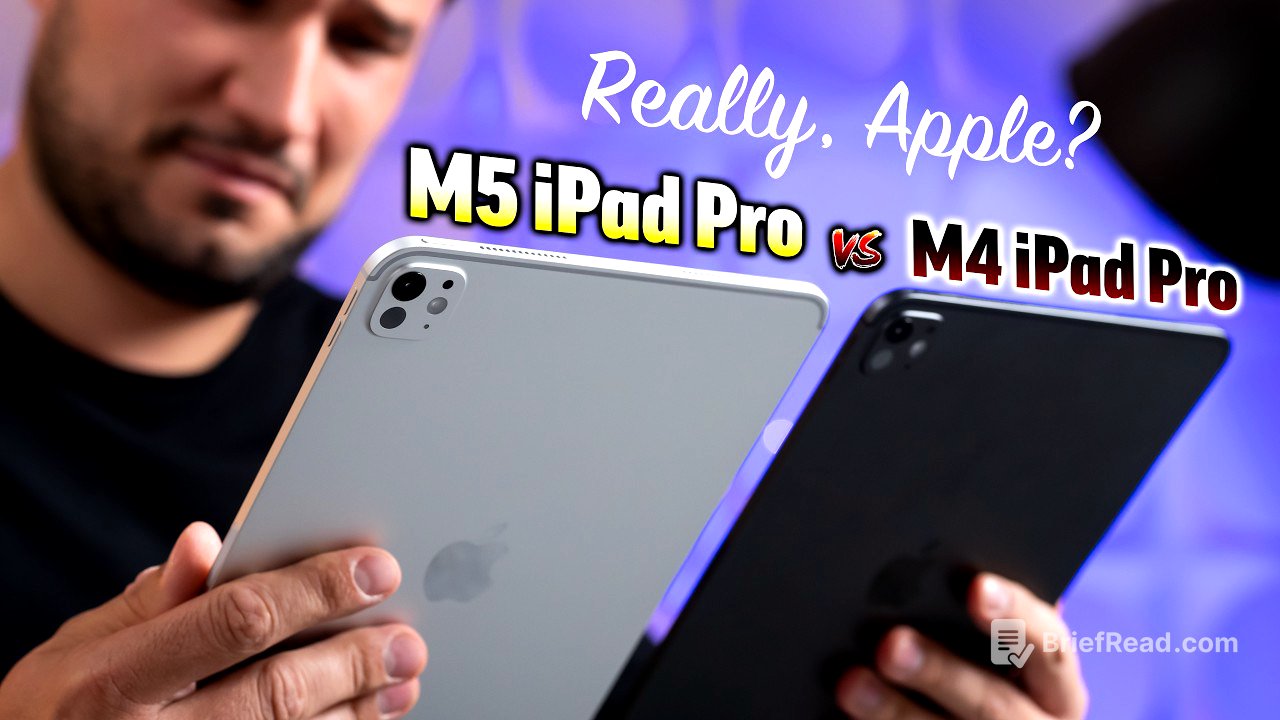TLDR;
The video compares the new M5 iPad Pro with the previous M4 model, focusing on performance improvements and new features. The M5 iPad Pro has a faster SSD, more RAM, and enhanced CPU and GPU performance, especially in AI tasks and ray tracing. While the design remains similar, the M5 includes Wi-Fi 7, better Bluetooth, and improved cellular efficiency. The reviewer recommends the M5 for those with older iPad Pro models but suggests that M4 owners need not upgrade.
- The M5 iPad Pro features significant performance improvements, particularly in SSD speeds, RAM, and AI-related tasks.
- Wi-Fi 7 and updated Bluetooth provide future-proofing and better connectivity.
- The design is largely unchanged, with the exception of the removal of the iPad Pro logo on the back.
Design and In-Box Contents [0:03]
The M5 iPad Pro features a super-thin design and improved displays, similar to the M4 model. The only external change is the removal of the "iPad Pro" logo on the back for a cleaner look. The in-box contents include a 20-watt power adapter, but for fast charging, a 40-watt or higher adapter is recommended to achieve 50% charge in 30 minutes.
SSD Speed Test [1:20]
The M5 iPad Pro demonstrates significantly improved SSD speeds compared to the M4 model. Read speeds are more than twice as fast, going from 1656 to 3413, while write speeds also double, from 1492 to 2876. These enhanced speeds contribute to a snappier overall user experience.
Geekbench 6 and CPU Performance [1:54]
The M5 iPad Pro comes with 12GB of RAM at the base level, compared to 8GB in the M4. In Geekbench 6 CPU benchmarks, the M5 achieves a multi-core score of 15,446, about a 15% improvement over the M4's 13,500. Single-core performance also sees an 11% increase, with a score of 4,834. While these scores are lower than the M5 MacBook Pro due to thermal constraints, the M5 iPad Pro still delivers impressive performance for its thin design.
GPU Performance and AI Benchmarks [3:00]
The M5 iPad Pro shows a 35% improvement in graphics performance, scoring 73,446 compared to the M4's 55,000 in Geekbench 6. This score is comparable to the M5 MacBook Pro, both having 10-core graphics. In AI tasks, the M5's GPU demonstrates significantly higher scores, with single precision scores about 26% higher and half precision scores more than double (2.3 times higher), making it ideal for AI-intensive applications.
Gaming Benchmarks and Thermal Performance [4:16]
In 3D MarkX Steel Nomad Light, the M5 iPad Pro shows less than a 10% performance difference compared to the M4, likely due to thermal limitations. However, in Solar Bay Extreme Unlimited mode, which utilizes ray tracing, the M5 achieves 28 FPS compared to the M4's 18.4, a 53% improvement. Thermal camera tests indicate that the M5 runs slightly cooler than the M4 during these benchmarks.
Wi-Fi 7 and Connectivity [7:21]
The M5 iPad Pro includes Wi-Fi 7, allowing it to connect to three different bands simultaneously for faster and more stable speeds. Speed tests reveal that the M5 can max out internet connections, achieving 926 download and 358 upload speeds compared to the M4's 768 and 90, respectively. The M5 also features the latest Bluetooth and supports 4K 120fps output with adaptive sync via USB-C, hinting at a new Apple display. The cellular version offers 30% less battery usage and better connectivity.
Final Recommendation [9:46]
For those deciding between the M4 and M5 iPad Pro, the reviewer recommends the M5 for its $100 price difference. However, M4 owners need not upgrade. Those with older iPad Pro models should consider upgrading to the M5 for its redesign, landscape camera, and future-proofing features. Refurbished versions offer a more affordable option.









